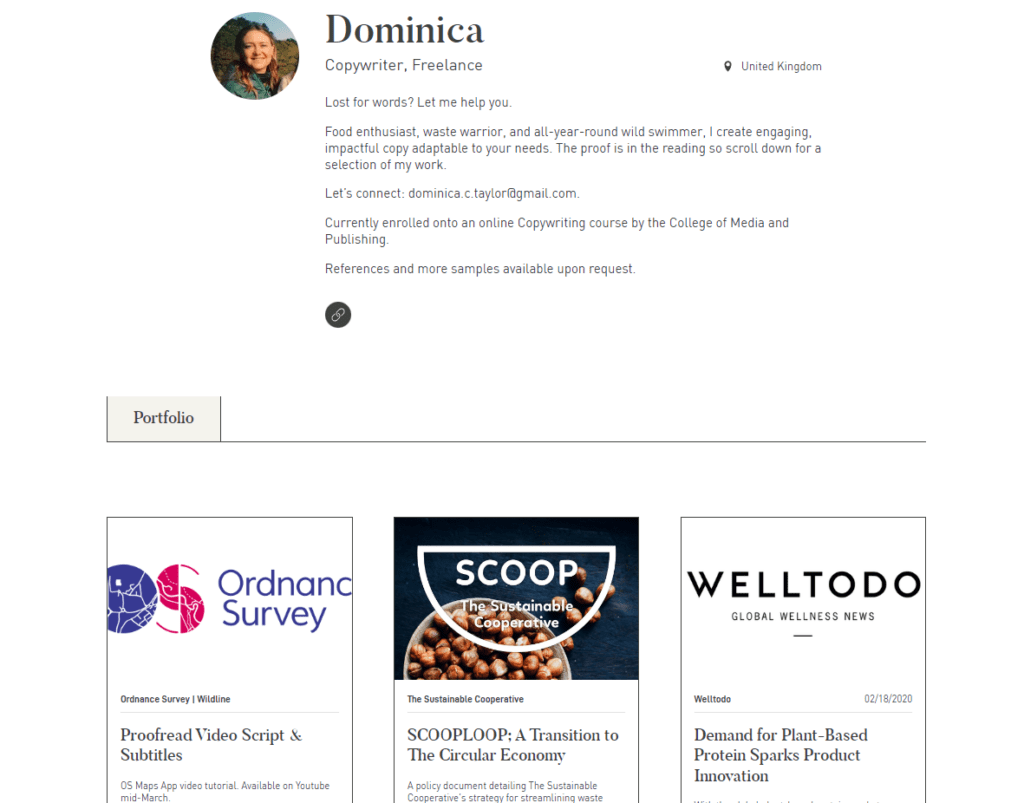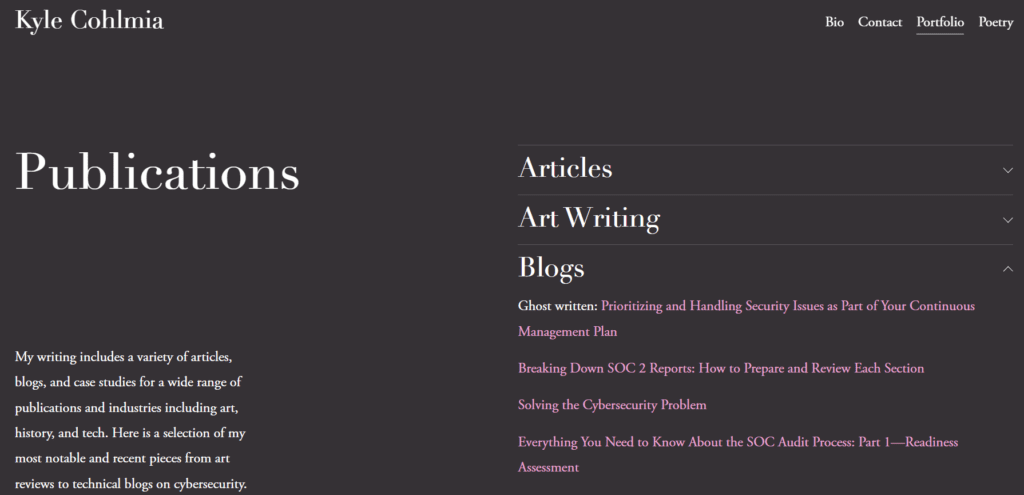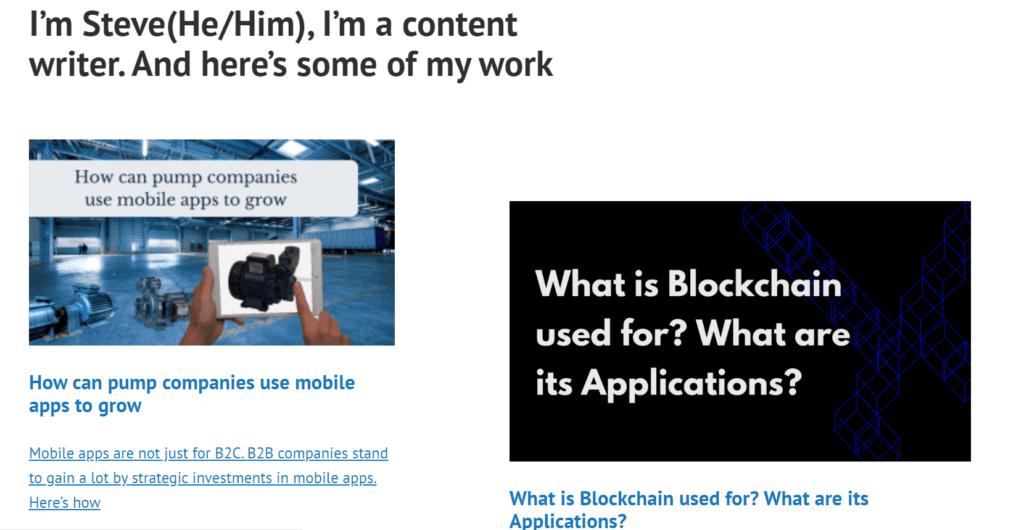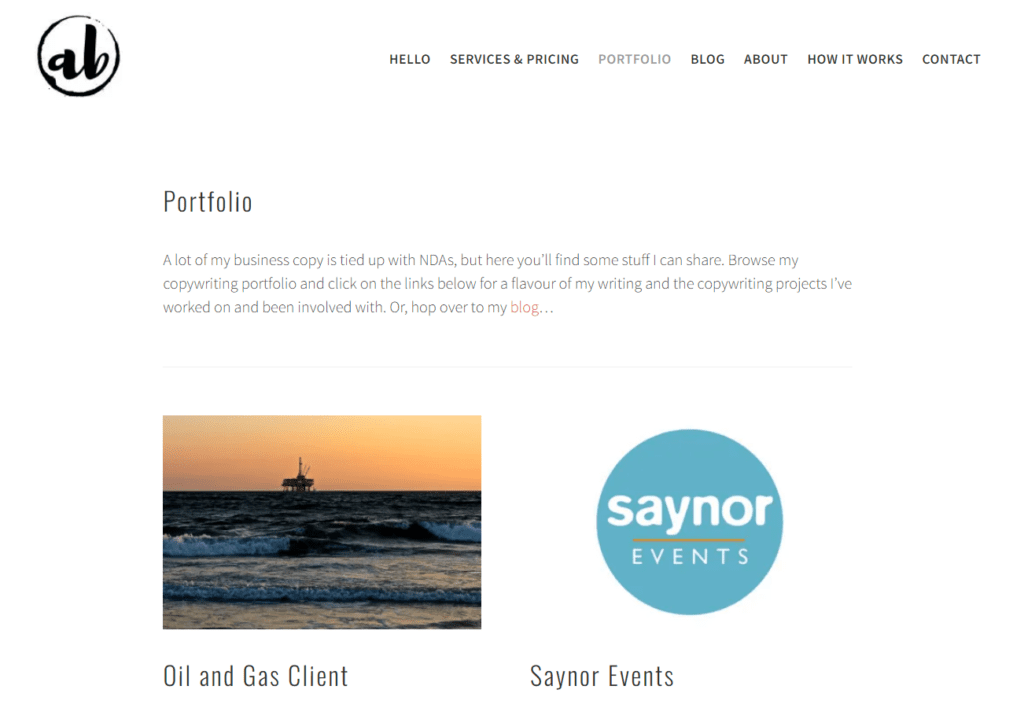Not sure what a content writing portfolio is or how to make one?
You’ll find the answers here.
Content writing and marketing are so popular right now – it’s mainstream. And these fields provide great opportunities to start a career as a content writer.
You might have noticed employers and clients asking for a content writing portfolio when picking writers.
You need to have an attractive and creative portfolio page if you want to even get considered for a content marketing or writing position.
Want to win over a potential client? You’re at the right place to the first step.
Learn all about writing portfolios and how to set them up.
What’s a content writing portfolio?
When employers or clients look for talented freelance writers, they need to see a body of work that shows what you can do.
An online writing portfolio is a link, page, or platform that has a collection of your writing work.
It will include:
- Blog posts
- Copywriting examples
- Email marketing copy
- Academic articles
- eBooks
And just about anything you’ve written that’s relevant to your goals and your customer’s requirements.
It’s the one place that shows people what you can do, and it will help business owners, editors, and employers figure out if they should hire you.
The benefits of an online writing portfolio
Having a content writing portfolio is essential if you want to be a successful freelance writer. Here are just a few of the benefits:
- It allows you to showcase your skills and demonstrate your experience to potential clients.
- It gives you a place to pitch ideas and share your samples with sites that accept guest posts.
- It helps you land projects with digital marketing agencies, who are always in need of high-quality content.
- You can share your experience and content with employers who can see what you can do
- You can save or store your live content and find them easily later.
- And finally, it gives you a sense of pride and accomplishment, knowing that your work is out there for the world to see.


So, we’ve covered the basics of an online portfolio and what it looks like. Let’s move to the next step – how to create a writing portfolio.
The Best Way to Build Your Writer Portfolio
While creating your writing portfolio won’t be complicated, it should be carefully thought out. It can have a huge impact on your career, you know?
Here’s what you should do.
1. Put your writing together
Before you can start putting together your freelance writing portfolio, you need to gather all your content in one place. This includes any blog posts, case studies, emails, pitches, and social media posts you’ve created.
If your content is live on a website, be sure to get the links. Or if it’s stored on a Microsoft Word document, copy it to a cloud-based document so you can share it easily.
When you have all your content gathered, find the ones that showcase your abilities the best. You’ll use these pieces on your portfolio site or document.
You also want to do a quick check of your previous work and make sure they’re edited and relevant.
Curating what you’ve written will ensure that you’re showcasing your best work.
2. Pick a solid portfolio platform
There are many places where you can collect and feature your content. You can use LinkedIn, Medium, and other social media networks. You can also create your own WordPress site and show your skills on your blog page.
And you can simply collect all your content in a document and file storage solution like Google Drive.
You can easily share your content through these platforms and they’re free!
However, you’ll also find dedicated writing portfolio websites. These are geared toward serious writers, researchers, and journalists. They’re also professional-looking and easy to share.
I think it’s good to use a ‘real’ portfolio platform to showcase your templates. Here are some sites to explore:
These platforms are available for free. But you get more options with a paid version.
If you’re just starting out, use one for free. And if you have the technical knowledge, you can even build your own WordPress site. You’ll have complete ownership of your site and content. And it helps to have a site of your own for personal branding.
3. Format or Section Your Portfolio
Depending on the platform you select, you’ll be able to create categories or sections for different types of writing.
For example, you might want to put all your tech content under one section or category.
Or you want to keep your newsletter copy separate from your white papers.
Begin by taking a step back and looking at the overall picture. What message are you trying to communicate with your writing portfolio? Do you want to show off your range as a writer? Or highlight a particular area of expertise? Once you know what direction you want to go in, you can start creating individual pages or sections for each writing sample.
If you don’t have this option, don’t worry about it. Just move ahead to the next step and start adding your content pieces to your online writing portfolio.
4. Start adding your content
If you’re using a site like Clippings.me, you’ll see options where you can just add a link, and you’re good to go.
Your writing will appear in a preview form on your profile page.
Anyone who wants to read the content in-depth will click on a link to check it out.
Remember to include a variety of writing samples so that potential clients can get a sense of your range.
For example, if you’re a copywriter, you might want to include samples of both long-form and short-form content.
Or, if you specialize in health and wellness, add links to your posts on meditation, fitness, and other relevant topics.
The more diverse your writing portfolio is, the better your chances are that some of your content will appeal to your audience.
However, if you’re targeting a specific type of client or industry, you’ll find it more effective to have a portfolio website or page for different areas.
So that if you’re applying for a writing job in the automobile industry, you can send your employer to a specific writing portfolio that’s all about cars or trucking insurance.
And if you want to pitch your services in the sports niche, you’ll have a page dedicated to just that.
5. Create A Professional Bio
The next step is to write a professional bio. This is a short paragraph (or two) that tells potential clients or employers who you are and what you do.
Take Julian Mack’s bio for example.


It’s not only professional but also tells you a bit about his personality. This is important because potential clients want to know if they will be working with someone they can get along with.
So your bio should have details but keep the format short, informative, and to -the point. Adding thumbnail images for samples will help your client quickly identify your work.
Your professional bio will help create a rounded picture of who you are, what you do, and how well you can serve a client.
6. Add Your Contact Information & Calls To Action
Don’t forget to add your contact information and a call to action on your writing portfolio page and author bio.
Your contact information should be easily accessible and should include your email address, phone number, and social media links.
As for the call to action, this is a short statement that tells visitors what you want them to do next. For example, you might say “Interested in working with me? Contact me today!”
This is important because it can compel your audience to move ahead and hire you to work for them.
Now, this makes it easy for potential clients or employers to get in touch with you if they’re interested in your services.
7. Share your writing portfolio
Make your writer portfolio live by publishing it – you can then share it with others.
You’ll often have to submit your writing portfolio while filling out a job application or when you’re having an email conversation with a possible client.
Now that you’ve collected, linked, and published your writing samples in one place, you can share them easily.
Don’t forget to add it to your LinkedIn and other networks. It’ll give people a chance to understand the niche you write for just by going through your portfolio page.
5 Portfolio examples to Inspire You
I’ve shared the best way to create and share your writing portfolio.
However, it’s even more helpful to have real-life examples to refer to.
Here is a list of solid content writing portfolio examples you should check out.
1. Dominica Taylor
Dominica is a copywriter and she uses Clippings.me to curate and share her work.
Her bio shares interesting things about her and she adds her email address to the profile.


Scrolling through her content, you’ll see plenty of samples of her work.
There is a variety of writing formats and topics. And they open new pages where a potential client can review their work.
I strongly recommend Clippings.me as a platform for freelancers and writers who don’t want to spend money on a premium product.
I used it to get a fantastic job and you can too.
2. Kyle Cohlmia
This is another real example of a writer with a great portfolio. Compared to the previous example, this one looks more impressive and attractive.
In this case, Kyle created a writing portfolio using SquareSpace. If you want to build a personal brand and control how your portfolio looks, then use a blog platform to create one.
I recommend using WordPress but you can check out other best blogger platforms too.


Kyle’s portfolio is impressive. And it’s not just because of the design.
The brief description showcases her writing career and how it spans areas like art and cybersecurity.
She doesn’t just feature blog posts she’s published, it includes art writing, serious articles and more.
Check out her work to see how you can do something similar.
3. Steve Manjaly
Here’s an example of a freelance content writer.
His focus is on tech topics like SaaS, IoT, Cloud, and AI.


He’s using WordPress.com to curate and share his portfolio.
Each of his sample posts features an image, a heading, and a brief subtitle.
Anyone looking for a tech freelance writer will find this useful.


The end of his writing portfolio has call-to-action inviting users to email and call him.
His bio also has a friendly picture of him and a description of his interests. It humanizes him and makes him interesting. You can also see links to his social media, including LinkedIn, Medium, and Instagram.
4. Amy Boylan


Amy also uses a self-hosted website platform.
She mentioned that most of her content is tied up because of NDAs or Non-Disclosure Agreements.
Readers are invited to read the content she can share. And she links to her blog to read more of her work.
Her portfolio is simple and effective.
5. Lucy Shrimpton


I like how Lucy Shrimpton has her online writing portfolio bang on her home page.
She directs readers to her content straight away.


She uses large images and features a variety of pieces. Clicking on the links takes you to web pages, print magazine articles, and work on her own blog.
It’s a clever and informative piece that helps you learn more about her.
And there you have it!
These are five brilliant examples of real content writing portfolios. With ideas from this site, you’ll find it easy to build your own.
FAQ
Q1.What to do if you don’t have samples or experience for your writing portfolio?
There are many ways to increase your writing samples and add writing experience to your portfolio. One way is guest posting. You can guest post on other writers’ websites or blogs to increase your portfolio.
Another way is to get published. You can submit your articles or stories to magazines, newspapers, or online publications. Once you are published, you can add these pieces to your portfolio website.
You can also write for different companies or websites as a freelancer. This will help you gain more experience as a writer and add more writing samples to your portfolio. Finally, you can create your own ‘writer website’.
This will allow you to showcase your writing skills and provide links to your published work and writing samples. Creating a writer’s website is a great way to increase your writing exposure and build your writing portfolio.
Points To Remember
You have now completed all the steps necessary to create an online content writing portfolio. By including thumbnail images and making it easy for clients to navigate, you have created a professional and stylish portfolio that is sure to impress.
Tips to remember:
- Keep it simple: You don’t need fancy graphics or unnecessary bells and whistles. Just focus on presenting your work in a clear, easy-to-navigate format.
- Highlight your best writing: Not every piece of writing you’ve ever done will be stellar. So make sure to only include your best work in your portfolio.
- Keep it up to date: As you land new writing gigs and produce more work, be sure to add it to your portfolio on a regular basis. This will help show potential clients that you’re an active, reliable freelancer they can count on.
- Finally, don’t forget to update your portfolio regularly! As your skills and experience grow, so should the writing samples in your portfolio. By regularly adding new and improved pieces to your portfolio, you’ll be sure to impress whoever comes across it.
Remember to showcase your best writing sample prominently, as this will be one of the first things potential clients will look at. With a well-crafted portfolio, you are now one step closer to landing your dream content writing job.
Now that you know how to create a content writing portfolio, it’s time to get started on your own. Use the tips and tricks in this article to put together a portfolio that will help you land the content writing job of your dreams!







